POINT: GB-21 (GALL BLADDER-21)
| English: | Shoulder Well |
| Also Known As: |
- Located at the highest point of the shoulder, halfway between DU-14 Dazhui and the acromion.
- Midway between DU-14 Dazhui and the tip of the acromion, at the crest of the trapezius muscle.
- On the shoulder, directly above the nipple, at the midpoint of the line connecting DU-14 Dazhui and the acromion, at the highest point of the shoulder.
- Straight insertion, 0.5 to 1 cun. Sensation: distention and soreness extending to the shoulder region.
- Caution: care should be taken not to insert the needle too deeply, to avoid puncturing the Lung.
- Posterior-oblique insertion, 0.5 to 1 cun.
- Caution: perpendicular insertion, especially in thin patients, carries a substantial risk of pneumothorax.
- Puncture perpendicularly 0.3 to 0.5 cun.
- Moxibustion is applicable.
- Meeting point of the Gall Bladder, San Jiao and Stomach channels with the Yang Wei channel.
- Relaxes the sinews
- Regulates Qi
- Activates the channel
- Alleviates pain
- Transforms and lowers Phlegm
- Dissipates nodules
- Benefits the breasts
- Expedites delivery
- Promotes lactation
|
|
SI-11 |
UB-42 |
|
Mastitis |
Shoulder pain |
Inability to turn the neck |
UB-12 |
HT-3 |
REN-3 or |
Pain of the shoulder and back |
Scrofula |
Retention of the placenta |
ST-36 |
LI-11 |
|
Pain and cold of the arm |
Pain and soreness of leg qi (first needle GB-21 Jianjing) | Shoulder pain Pain of the forearm |
DU-20 |
|
|
Rectal prolapse |
|
|
- Contraindicated during pregnancy
- Use caution for those with Heart problems.
- This point has three main functions:
1. It treats Bi syndrome of the shoulders and neck.
2. It promotes lactation in nursing mothers.
3. It is used for many problems involved in childbirth. - This is a very powerful point.
- This is a key secret point for knee problems, because it sends the Qi downwards.

